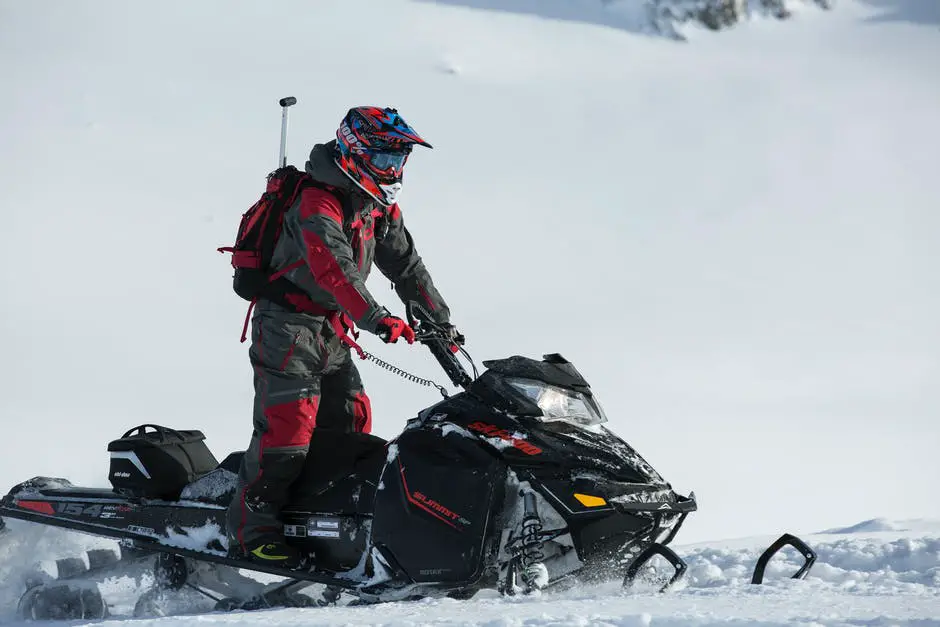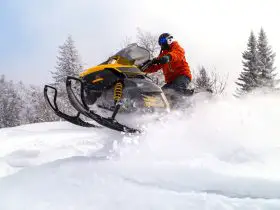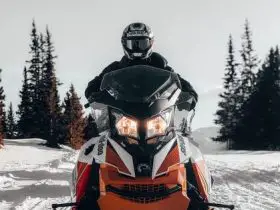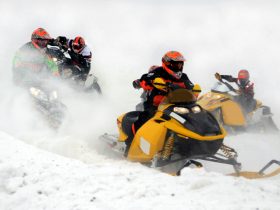Did you know that there are more than 600,000 registered snowmobiles in Canada? In the frozen north, snowmobiles are a normal part of day-to-day transportation and for intense recreational activities.
While in the United States, there are over 1.3 million registered snowmobiles, with snowmobiling across both countries now worth more than $30 billion combined, according to the International Snowmobile Manufacturers Association.
Snowmobiles can explore rough country terrain that even hikers avoid during the summer months. The only downside? Many snowmobiles are so loud that they scare off wildlife.
Modifying an exhaust, adding new mufflers, and installing hood insulation foam have a nominal impact on the sound of snowmobiles. Upgrading aspects of your existing snowmobile can be as costly as the machine itself. Read this guide to learn more about the best options for the quietest snowmobile and what makes these machines a modern revolution in the industry.
Table of Contents
What Makes Snowmobiles Quiet?
Great maintenance is key to keeping your snowmobile quieter. Even the smallest hole or crack on or around the exhaust can add decibels to your ride. Exhaust manifold leaks further increase the noise of your machine.
The longer you have your snowmobile, the more you’re likely to deal with engine issues. Muffler packing often comes loose or damaged from prolonged use. Replacing your muffler insulation material is a tried and tested means of reducing the noise of your snowmobile.
Older snowmobiles don’t tend to have insulation foam inside the side and hood panels. Industry experts noted this issue, so most new snowmobiles now come with insulation foam added to these areas.
Snowmobile enthusiasts might want to add performance modifications to their machines. Anything that increases your engine performance will make it louder. Avoid any add-ons to your snowmobile, and you’ll get the added bonus of greater durability and reliability.
While making updates to your sled are viable options to reduce the noise, new models are your best option. So, what makes newer models so much better?
Where Does the Noise Come From?
Radiated engine noise on snowmobiles comes from the hood vents, air gaps, and any unseal seams around the engine compartment. The noise radiates from the engine block directly into the components mounted on top.
The worst snowmobiles will physically vibrate from the radiated engine noise. It can be very expensive to fix these issues, so most users will scrap older models for new ones.
Tracks and the suspension on snowmobiles will create noise whether they’re on snow or not. The track creates noise when lugs bite down on the snow to propel the machine forward.
Intake and Exhaust noise are also related to the engine. While exhaust noise is considered the main source of sound on a snowmobile, intake noise can be mitigated. All newer models of snowmobiles have as many upgraded to silence intake noise.
However, buyers are still given options on engine noise. Most models of snowmobile come with a two-stroke engine, but the four-stroke is definitely quieter.
Four-Stroke Engines
The quietest snowmobiles all have four-stroke engines. The difference between the two-stroke and four-stroke engines is that the four-stroke has fewer explosions at any given RPM.
There are half as many explosions in a four-stroke engine compared to the older two-stroke models. With fewer explosions, you’ll have a quiet snowmobiling experience.
Four-stroke engines also have a varied exhaust design. With restricted exhaust systems and both exhaust and intake valves, noise is separated and dispersed. This leads to a low noise emission for your machine.
Lower frequency soundwaves are part of the norm in four-stroke engines. Healthy humans have a hearing range of 20 to 20,000 hertz. A lower frequency soundwave makes a snowmobile quieter to humans, at least!
Turbocharged Snowmobiles
A turbocharger on a snowmobile generally lowers the noise emissions. A turbocharger is essentially just an air pump that creates a boost to the power of your machine.
The combustion process on a snowmobile turbocharger splits three different ways. Part of the pressure goes to the crank to create power. Some of the energy goes to the cooling system, so your snowmobile doesn’t overheat. The remaining energy goes to the exhaust.
When installed correctly, a turbocharger will create low system restrictions and low charge temperatures. The lowering of the RPM will boost the threshold without adding noise.
Industry Standard Measurements
All new models of snowmobile have their sound measured by microphone before being put on the market. The sound pressure level is presented in decibels (dB).
Some manufacturers measure snowmobile sound by the power it produces. As most of the complaints about snowmobiles come from bystanders, not users, snowmobiles are tested by proximity to the machine.
If you need to know both the sound pressure level and the sound power of your chosen snowmobile, you can research the dBA. Even though noise is something most users want to be reduced, some sound is good.
You can tell the health of your snowmobile by the sounds it makes. The last thing you want is to be unaware of an issue before it’s too late. Therefore, some sound is good.
Quietest Snowmobile on the Market
In the next section, we’ll review the best models of quiet snowmobiles. Not all of the models in this list feature four-stroke engines. Regardless, these are some of the quietest models but also the cleanest for the environment.
It is almost impossible to Google Search the quietest snowmobiles, as very few models advertise as such. Instead, choosing the quietest snowmobiles is done by checking out the specs. We’ve created a list of our favorite quiet snowmobiles on the market.
Yamaha RX-1
The Yamaha RX-1 is yet another example of why the brand is known as a dependable manufacturer of snowmobiles. The four-stroke, 998cc, 4-cylinder, DOHC, 5-valves-per-cylinder, liquid-cooled Genesis Extreme engine is the same found in Yamaha motorcycles.
The only major difference between the motorcycle and snowmobile is that the snowmobile uses four Mikuni BSR37 carburetors with a peak of 145 hp at 8300 RPM. Speed is no concern on this quiet snowmobile, with a top speed of 137mph.
Even at top speeds, the RX-1 is one of the comfiest snowmobile rides on the market. The front suspension has upper and lower A-arms with a single coil-over shock on each side. In the rear, the suspension features 11.5 inches of vertical travel.
An oversized disc brake makes stopping fast, whether you’re on the 121-inch or 151-inch track models. For the extra luxury, Yamaha included individually controlled hand warmers. There is even a reverse gear with an easy lever for when you head off course.
2020 Ski-Doo Expedition Xtreme 850 E-TEC
The quiet drive-line system of the latest Ski-Doo model is perfect for all snowmobiling needs. For serious snowmobilers, the Expedition Xtreme can haul gear like the best utility sled.
Users have described the Expedition Xtreme as providing a floating feeling as they glide through the snow. Uphill and downhill environments don’t suffer on the latest Ski-Doo model. All types of tracks work for this model.
Despite the lack of turbocharger and coming with a two-stroke engine, the Ski-Doo is one of the quieter snowmobile models available. The length of the machine is almost 11ft, with a dry weight of 595lbs.
The best thing about the Ski-Doo Expedition Xtreme is that, even after prolonged use, it’s one of the top-rated machines for comfortable, agile riding. Reviewers have also commented that this machine handles great, with optimum control.
Ski-Doo Legend V-1000
Ski-Doo creates the best models of quiet snowmobiles at more than reasonable price points. After 2003, this model came with a four-stroke engine, making them even quieter.
Comparable to a Harley Davidson, the V-1000 is designed for leisurely cruising with 121-inch tracks, twin rear variable-rate shocks, and a single trailing arm from suspension. Fitted with LCD instruments, hand warmers, and electric start and reverse options, the V-1000 remains popular today.
Polaris 120 INDY
Great for young riders, the 120 INDY hosts a 120cc four-stroke engine. Families of snowmobilers would struggle to find a better model on the market for first-time riders.
Thanks to the four-stroke engine, the noise reduction on the 120 INDY shouldn’t damage your youngster’s hearing prematurely. The adjustable throttle allows you to control just how much power your rider needs.
What is most beneficial about the 120 INDY is its long-term durability. Like a great old car, the 120 INDY is an investment that multiple generations of the same family can enjoy.
Considering a Quiet Snowmobile?
Whether you’re based in the northern United States or anywhere in Canada, a snowmobile is a super source of fun, recreation, and practical travel. Throughout the winter months, the quietest snowmobile can become your day-to-day vehicle.
Off-roading experiences are easier with a snowmobile, and you can even do long-distance travel with these machines. If you’re not entirely sure what type of snowmobile you’d like, you can keep checking back to the site to see our latest articles. We have all of the information you need to stay ahead of the game!










